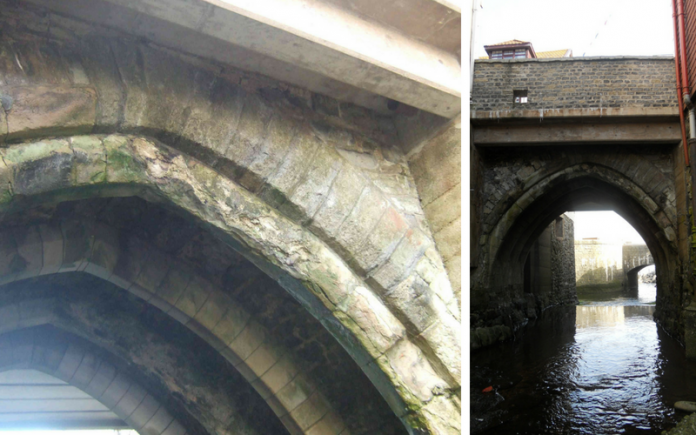In Lyme Regis, hidden under the road and only properly seen from the riverbed, lies the third oldest bridge in Dorset.
Buddle Bridge is a single span bridge with four equally spaced, pointed segmental, ashlar ribs – most likely dating from the early 14th century.
Since 1998, Dorset Highways has been working towards replacing load-bearing stonework, which has eroded to the point of failure and is essential to the bridge’s survival.
Looking downstream, the second and fourth ribs were replaced in 1971. The originals were missing (presumably having collapsed a long time ago) with the springer stones worn back to the abutments by the elements. The replacement ribs remain in good condition.
The remaining two, original ribs are extremely weathered to the extent that, in parts, only 50% of the original section is estimated to remain. Previous repairs to sections of the ribs are visible and some of these repairs are also damaged. Other parts of the original stonework to the ribs were found to be cracked and delaminated.
If either of these ribs were to collapse the structure probably would remain supported by the three remaining ribs, but there might be further localised collapse of the main arch barrel – risking damage to the road over the bridge, which is the main route through Lyme Regis.
The original scheme was to replace the worn stones in two of the arch ribs and strengthen the concrete footway adjacent to the bridge. In 1998, Listed Building Consent (LBC) was granted for this work but budget constraints forced the work to be cancelled.
The reinforced concrete footway was eventually rebuilt in 2007. In 2015, a re-application for LBC was submitted for the arch rib work but was rejected because it was considered that too much of the original, historic material was to be removed.
After further reports by archaeologists and consultant conservation engineers it was proposed to only replace the missing or badly eroded parts of the arch rib stones, leaving as much of the original stonework as possible.
Though losing some of the sense of age from weathered stonework, it was agreed this approach would retain the bridge’s considerable historical and archaeological significance, as well as preserving any aesthetic value by keeping the shape and form of the structure.
So, 17 years into the project, the next challenge was finding a suitable material to use as replacement stones in the arch rib.
The original stone was identified as Salcombe Stone, which is no longer commercially quarried. As it was known that Exeter Cathedral uses this type of stone (along with 25 other types), the Clerk of Works for the cathedral restoration was contacted. He confirmed that only five cubic metres of Salcombe Stone is quarried each year and it is all stored for use at the cathedral.
After long discussions between engineers, planning consent officers and England Heritage, the use of Purbeck Inland Freestone as a substitute for Salcombe Stone was accepted, as it represented an ‘honest’ repair – being obvious though not too obvious.
At last, work started in July 2018 to replace three stone blocks in the first rib and repair 19 stone blocks in the first and third rib.
Repairs to the bridge will be finished by the end of this month (August).











